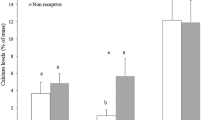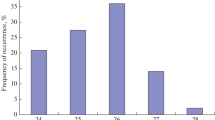Abstract
Factors concerning sexual discrimination and related sensory receptors were investigated on the hermit crabPagurus geminus. In the breeding season, male crabs of this species were observed to hold receptive females but to reject males. By using this behavior, it was examined whether males on which some operation on the sensory receptors was performed could discriminate between presented male of female crabs. Test males could not discriminate sexes of the presented crabs only when antennules were removed bilaterally. On the other hand, intact test males reacted positively to an empty shell from which “female water” exuded after passing through the chamber containing females. Thus, the factor by which the hermit crab discriminates sexes was indicated to be a water-borne chemical and that the sensory receptor related to sex-discrimination appeared to exist on the antennules. Discussions are made with respect to predicted substances taking part in sexual discrimination of this hermit crab.
Similar content being viewed by others
References
Ameyaw-Akumfi, C. & B. A. Hazlett 1975 Sex recognition in the crayfishProcambarus clarkii Science 190: 1225–1226.
Atema, J. & D. G. Engstrom 1971 Sex pheromone in the lobster,Homarus americanus.Nature 232: 261–263.
Barber, S. B. 1961 Chemoreception and thermoregulation. In: T. H. Waterman (ed.)The physiology of Crustacea, Vol. II. pp. 109–131. Academic Press, New York and London.
Christofferson, J. P. 1972 The site of chemoreceptors sensitivie to the sex pheromone of the female crab,Portunus sanguinolentus (Herbst).Am. Zool. 12: 690.
Crane, J. 1957 Basic patterns of display in fiddler crabs (Ocypodidae, genusUca).Zoologica 42: 69–85.
Dunham, P. J. 1978 Sex pheromones in Crustacea.Biol. Rev. 53: 555–583.
Eales, A. J. 1974 Sex pheromone in the shore crabCarcinus maenas and the site of its release from females.Mar. Behav. Physiol. 2: 345–355.
Ewing, A. W. 1977 Communication in Diptera, In: T. A. Sebeok (ed.)How animals communicate, pp. 403–417. Indiana Univ. Press, Bloomington & London.
Gleeson, R. A. 1976 Pheromone-mediated behavior in the blue crab,Callinectes sapidus.Am. Zool. 16: 197.
Gleeson, R. A. 1980 Pheromone communication in the reproductive behavior of the blue crab,Callinectes sapidus.Mar. Behav. Physiol. 7: 119–134.
Hazlett, B. A. 1966 Social behavior of the Paguridae and Diogenidae of Curacao.Stud. Fauna Curacao 23: 1–143.
Hazlett, B. A. 1970 Tactile stimuli in the social behavior ofPagurus bernhardus (Decapoda, Paguridae).Behaviour 36: 20–40.
Hidaka, T., K. Yamashita & A. Niizuma 1982 Behaviour of animals. Tokai Univ. Press, Tokyo, 192pp. (in Japanese)
Hölldobler, B. 1977 Communication in social Hymenoptera. In: T. A. Sebeok (ed.)How animals communicate. pp. 418–471. Indiana Univ. Press, Bloomington & London.
Kamiguchi, Y. 1972 Mating behavior in the freshwater prawn,Palaemon paucidens. A study of the sex pheromone and its effect on males.J. Fac. Sci. Hokkaido Univ. Ser. VI, Zool. 18: 347–355.
Kittredge, J. S., M. Terry & F. T. Takahashi 1971 Sex pheromone activity of the moulting hormone, crustecdysone, on male crabs.Fish. Bull. 69: 337–343.
Kurata, H. 1968 Larvae of Decapoda Anomura of Arasaki, Sagami Bay-I.Pagurus samuelis (Stimpson) (Paguridae).Bull. Tokai Reg. Fish. Res. Lab. no. 55: 265–269.
McLeese, D. W. 1970 Detection of dissolved substances by the American lobster (Homarus americanus) and olfactory attraction between lobsters.J. Fish. Res. Bd. Canada 27: 1371–1378.
Otte, D. 1977 Communication in Orthoptera. In: T. A. Sebeok (ed.)How animals communicate. pp. 334–361. Indiana Univ. Press, Bloomington & London.
Ryan, E. P. 1966 Pheromone: Evidence in a decapod crustacean.Science 151: 340–341.
Salmon, M. 1965 Waving display and sound production inUca pugilator, with comparisons toU. minax andU. pugnax.Zoologica 50: 123–150.
Salmon, M. 1983 Courtship, mating system, and sexual selection in decapods. In: S. Rebach & D. W. Dunham (eds.)Studies in adaptation: The behavior of higher Crustacea. pp. 143–169. Wiley-Interscience. New York.
Salmon, M. & J. F. Stout 1962 Sexual discrimination and sound production inUca pugilator Bosc.Zoologica 47: 15–19.
Silberglied, R. E. 1977 Communication in the Lepidoptera. In: T. A. Sebeok (ed.)How animals communicate. pp. 362–402. Indiana Univ. Press. Bloomington & London.
Von Hagen, H. O. 1962 Freilandstudien zur Sexual- und Fortpflanzungsbiologie vonUca tangeri in Andalusien.Z. Morphol. Ökol. Tiere 51: 611–725.
Author information
Authors and Affiliations
About this article
Cite this article
Imafuku, M. Sexual discrimination in the hermit crabPagurus geminus . J. Ethol. 4, 39–47 (1986). https://doi.org/10.1007/BF02348251
Received:
Accepted:
Issue Date:
DOI: https://doi.org/10.1007/BF02348251




